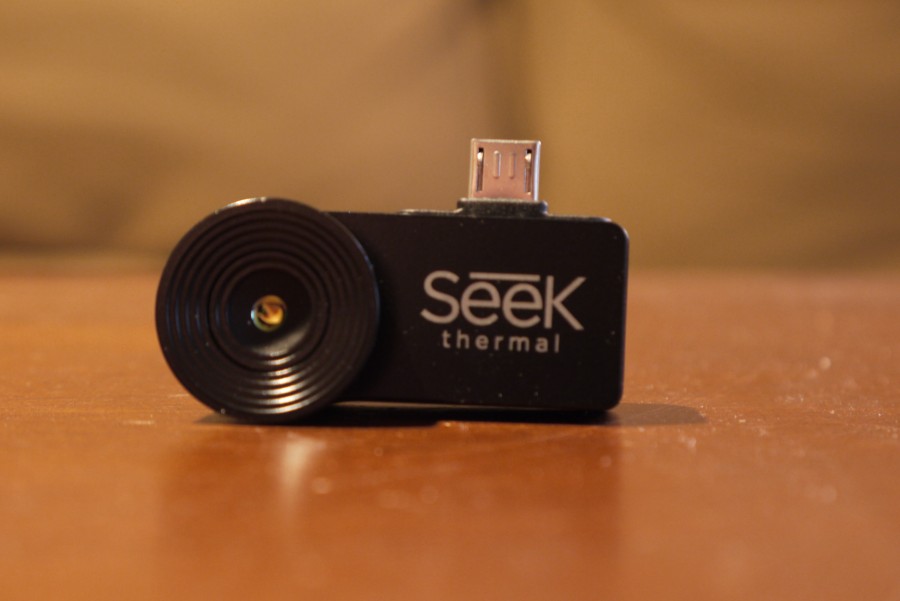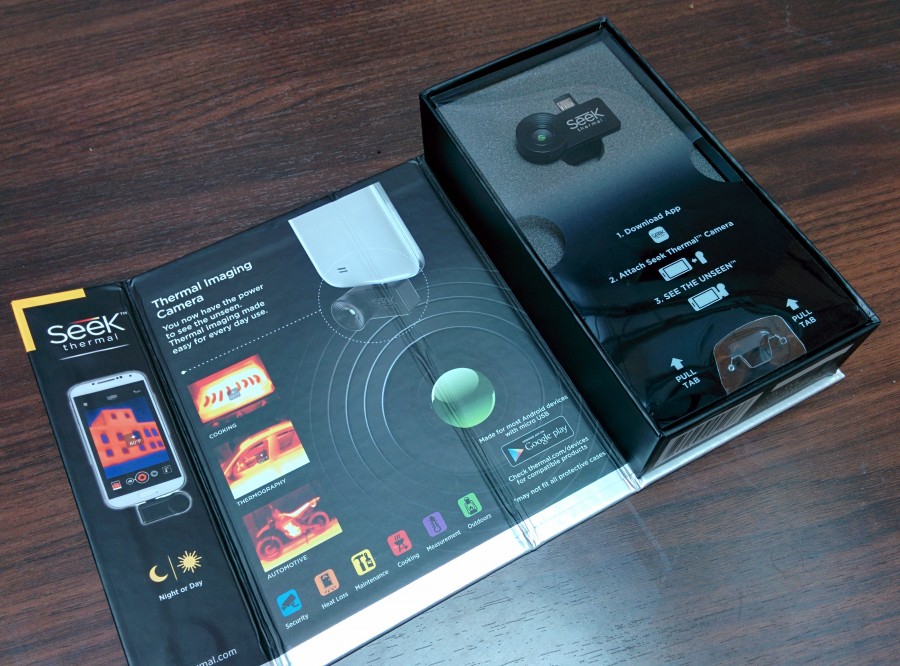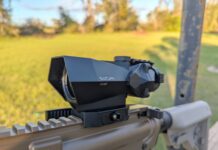Thermal optics are amazing. Using a part of the light spectrum that we can’t see, they can turn a pitch black night into virtual daytime, showing us a completely new level of detail. The downside: they cost an astronomical amount of money if you want to use them on your gun. The cheapest option available right now clocks in at $3,500, not a small sum for those who might just want to use that tech once or twice a year for hunting. Thankfully there have been a number of companies bringing consumer-grade thermal optics devices to the market. One of the more interesting is the $250 Seek Thermal camera, designed for smart phones . . .
The idea behind the Seek Thermal camera is pretty slick. Since most people already have a tiny computer with a great display in their pockets (a smart phone), all you really need is to find a way to get the thermal sensor attached to the phone and the rest can be accomplished using an app on the phone itself. The more expensive bits of the thermal camera are already a sunk cost (namely the phone), so the sensor is the only bit you really need to buy. That means the camera can be smaller, cheaper, and easier to produce.
Why, you ask, is a consumer grade thermal imaging sensor being reviewed on a firearms website? Hunting, my friend. As anyone who has spent some time in the woods with a rifle will tell you, those delicious furry critters have developed some pretty effective camouflage over the centuries. Finding a motionless whitetail standing in a field of tall autumn grass is like finding an original Luger with a $200 price tag — it happens, but not often and not very easily.
The one thing that these creatures haven’t been able to hide is their heat signature, and that’s something that a thermal imaging sensor can detect no matter if the sun is shining or not. Its a definite advantage to the hunter. If it works.
The Seek Thermal camera is designed to attach to the USB (or Apple’s equivalent) port in your smartphone. In theory, it should point forward and allow you to use your phone as a window on the thermal world. It does indeed function as designed, but there’s a problem.
USB ports aren’t symmetrical — devices only fit if you plug them in a certain way. For some phones this works fine, but for others (like the Nexus line) the plug is aligned ‘backwards’ and the camera becomes a $250 thermal selfie machine. To combat this, you can buy a small extension cord for about $1 that lets you swivel the camera independently of the phone.
The camera works with a free app you install on your phone that offers some cool functionality. You can set the color palette to use different gradients for visualizing the data (from a thermal-y rainbow to the more traditional white hot or black hot visuals). It even sports an option to have it measure the heat of a specific spot on the image or simply let you know the temperature of the hottest and coldest points. That’s handy for monitoring cooking temperatures, I suppose. You can also snap pictures directly from the app and even record video.
Using the camera with an Android phone is remarkably easy. As soon as you plug in the camera, the phone launches the relevant app. Navigating the app and getting it to do what you want is similarly simple, and everything is laid out in a logical manner. It seemed very well polished to me.
Let’s talk for a moment about the difference between “detection” and “identification.” When a thermal optic says it can “detect” something at up to 1,000 feet, what they are really saying is that “one single pixel will change color.” You will detect…something. But what exactly that something is will be impossible to determine. Seek Thermal says that their “identification” range for this camera is 150 feet. In other words, you can positively identify what that single pixel represents when you are 150 feet — or 50 yards — away from the object.
Even close up, the resolution on the camera isn’t the greatest. You can kinda see what’s going on, but identifying hard edges of shapes is difficult. The live video stream is grainy, and there are frequent pauses while the sensor re-calibrates. In short, it isn’t ideal — but it works.
Out in the field, the camera isn’t really suited for finding delicious furry critters. The temperature spread between the ground and the animal isn’t sufficient to make it stand out during the day, and the low identification distance means that your footsteps will scare off your prey before you get close enough at night. That is, if the giant glowing display in front of you hasn’t done the job already.
In the end, the Seek Thermal camera is a mixed bag. The price and ease of use mean that almost anyone can now pick one up and try it out without too big an investment, but the trade-off for that low price is low resolution and an inability to recognize objects at much of a distance. For tech nerds, the camera is amazing — the ability to watch your gun as it heats up and see which parts get hottest is really cool. But for hunting, the camera leaves a lot to be desired. You get what you pay for, and for some situations that might not be enough.
Specifications: Seek Thermal Camera for Smartphones
MSRP: $250
Ratings (Out of five stars):
Finish: * * * * *
Great packaging, excellent app, and a slick design.
Function: * *
Low resolution and only one direction available for the USB orientation leaves something to be desired.
Overall: * * *
For general farting around with thermal images, this is the tops. But if you want to actually use the camera to go hunting, you’re probably going to want to spend the money on a FLIR. Worth the money, but when an “okay” optic clocks in at $3,000 that might not be saying much.






The one FLIR makes is pretty sweet. I have used one in person.
http://flir.com/flirone/
My initial question is, will it work better if the lens is bigger?
Might be a stupid question, but I really want this to work. Because I want it.
Short answer, maybe, depending on what you want to use it for.
All else equal, a bigger lens collects more light, so you can get either a better image, or the same image faster. But ir optics tend to be pricey and just like any other lens, the bigger they are the more expensive it is to keep the optical quality up.
The other part of the equation is the sensor. The more pixels a sensor has, the higher resolution an image it can generate, again all else being equal, and the further away you can in principle identify something.
But for the same sensor size, more pixels means each pixel gets less light, so you need a bigger lens to keep up acquisition speed and contrast. But that bigger lens has to be of good optical quality or your sensor is going to just give you a higher resolution blur. 🙂
So as your lens gets bigger you’ll want to increase the pixel count but this means your optical quality will likely need to get better as well; which is one reason FLIRs cost so much – you’re increasing the performance requirements along three axes at the same time: pixel count, lens size and optical performance.
Isn’t there also a direct correlation between sensor temperature and signal noise?
Better than the REALLY overpriced FLIR iPhone 5 case, which I’ve now seen advertised for $250 ($100 off). For boring stuff like “how much warm air am I losing through my ceiling” it works better than an educated guess. I suspect the 2nd gen of this will be MUCH better. I had to wait 3 months to get my Lightning unit due to, well, something Apple related, so I missed using it during deer season.
I handed it around to the geeks at work to play with after I was done. None is planning to rush and buy a Seek, but all felt the packaging/casing/unit quality were up to snuff, and there are 5-6 more people with the thermal.com site in their favorites.
I’ll take it to the range next week, the super cold air should make for pretty pictures.
Note: I use mine on an iPad Mini Retina with a UAG Scout case, and it required aggressive trimming of the case to get the unit to mount. I also couldn’t get the app until I told the Store to show all apps, not just iPad apps.
Impressive, not for what it is, but for what it suggests is possible.
Hmm, anyone got a bead on how much a naked sensor costs? As a programmer I’m thinking some day I could just build/code my own.
Yeah, the next step is definitely the naked/X-ray cam. Kind of like the X-ray glasses they used to advertise in comic books when we were kids (although, I never knew anyone who was gullible enough to actually order a pair).
The naked/X-ray capability needs to be built into the hardware. But if you’re coding the app, you need for it to differentiate between the hot women and everybody else (e.g., OFWGs).
This is very cool and the demo video is impressive, especially for the price.
Heh, for the record I mean the flir sensor itself, I’m not a perv. Although maybe we could send one to mda…
Not exactly naked but knock yourself out. I’d love to get one:
https://www.sparkfun.com/products/13233
Nick, you talk about using this technological marvel for hunting. Aside from throwing any concept of fair chase out the window, if folks follow your advice, in many (if not most) states, they’ll be in violation of state laws prohibiting the use or possession of night vision equipment while hunting. (I believe that in some places, there are exceptions for hogs and varmints, but you talk about deer in your write-up.) However, you may wish to put a disclaimer in your review.
In CA, the restriction was legislated specifically for the Korean War era M3 Carbine with “Sniper Scope”, meaning an infrared light source with a passive receiver. Thermal imaging was never addressed, nor was the green laser fad from a few years ago. The benefits of having a stupid Assembly and executive branch, I guess. Some do-gooder wet their pants at the poor North Koreans and Red Chinese getting shot down at night and wrote/passed a law.
Here it is: http://www.leginfo.ca.gov/cgi-bin/displaycode?section=pen&group=00001-01000&file=466-469
468. Any person who knowingly buys, sells, receives, disposes of,
conceals, or has in his possession a sniperscope shall be guilty of a
misdemeanor, punishable by a fine not to exceed one thousand dollars
($1,000) or by imprisonment in the county jail for not more than one
year, or by both such fine and imprisonment.
As used in this section, sniperscope means any attachment, device
or similar contrivance designed for or adaptable to use on a firearm
which, through the use of a projected infrared light source and
electronic telescope, enables the operator thereof to visually
determine and locate the presence of objects during the nighttime.
Minnesota’s is part of the game hunting regulations:
“A person may not possess any kind of night vision or thermal imaging
equipment while taking wild animals or while possessing a firearm, bow, or
other implement that could be used to take wild animals.
This regulation does not apply to 1) a firearm that is unloaded, cased, and
in the closed trunk of a motor vehicle; or 2) a bow that is cased or unstrung,
and in the closed trunk of a motor vehicle. If the motor vehicle does not have
a trunk, the firearm or bow must be placed in the rearmost location of the
vehicle.”
http://files.dnr.state.mn.us/rlp/regulations/hunting/2014/full_regs.pdf
So – Like the man says – check your local laws.
+1. Thanjs Nick. Kewl toy, and second the caution by others to check state law.
I’ve seen different claims by internet experts on thermal gear in CA, and nite there’s state law, penal code:
http://www.calguns.net/calgunforum/showthread.php?t=811567
And also Fish and Game hunting regs, that you can look up, or sometimes get a recent question answered by this CDFG biologists weekly column, if you google around for it:
http://latimesblogs.latimes.com/outposts/2010/12/fish-and-game-q-a.html
My bad for earlier mis-spelling on Bruce Colodny as an example of a gun lawyer to call to see how recent cases are heing handled, where the law is applied, variably or not…CA law can be confusing for wardens, too.
http://www.gunlaw.com/gun-law-articles/17-hunting-in-california-a-legal-survival-guide.html
Found a guy on YouTube who did a comprehensive tear-down on the Seek Thermal Camera…
Seek Thermal camera teardown part 1 (and 2)
https://www.youtube.com/watch?v=8Cr8oZck5m8
eBay shows both macro and zoom lenses for the Seek Thermal unit. I’ve seen places selling sensor dev kits, but they’re usually more than the compete unit.
I think the thing most people are overlooking, is that this is the first major foray into consumer level (affordable) thermographic systems. Starting from this unit, we could be seeing thermographic cameras, video surveillance systems, scopes, etc. Now that flir doesn’t have a stranglehold on the market, they’ll need to compete to stay relevant.
“Out in the field, the camera isn’t really suited for finding delicious furry critters. The temperature spread between the ground and the animal isn’t sufficient to make it stand out during the day, and the low identification distance means that your footsteps will scare off your prey before you get close enough at night.”
Nick, can you give us the approximate day/night ambient temperatures when you tested this device?
I wonder how different its game finding performance would be in Minnesota than Texas. The larger temperature differential between game and ground may make the device work better in cooler climates.
I’m actually more interested in a device like this for scouting and determining game patterns. For that purpose, high resolution isn’t always necessary. It is enough to just see a few glowing blobs.
This looks interesting.
http://tplogic.com/thermal-solutions/t10/
I’m interested in the camera for trailing downed game. Anyone done or seen any test on how it would work for seeing blood trails and whether or not you could “see” downed game in moderate cover.
I too wanted this to work so bad. I hunt pigs in North Louisiana. I have a Armasight Vampire NV scope with a T-20 illuminator but after renting a couple different thermal units (Eotech 320 monocular and a Armasight Thor 320), thermal is clearly the way to go, just can’t justify the $’s, YET. I can justify $250 though.
I would say that the review is spot on. I am generally scanning wide open corn fields from the road and SOMETIMES it will give me an indication that there is “something” out there out to a few hundred yards. If I see something, I can confirm with the NV scope. One big problem is the focus. Its a cheesy set up so any time you bump the lens, you need to refocus. Big difference in quality between a focused and not focused image.
Where this thing really does shine is finding the pig in the field after you shoot it. A lot of times if its a 100-200 yard shot, Ill go back to the wheeler and head in the direction I thought I shot at. Depending how far I stalked from the wheeler in the first place, this can be a challenge. I have driven all over the field more than once before I found the pig. With the Seek, a quick scan and the location of the animal was determined instantly. For this reason alone I have kept it.
Spend a couple hundred more dollars for the SEEK hand-held. The reviews are much better on all functions. I see it useful for tracking down game whether it is a deer that went down hundreds of yards away in a field of tall grass or brush… you may think you have them marked, but in the excitement you can loose the spot especially if it gets dark. Could be useful for finding fallen fowl as well…for the same reason. I do like the night time videos on youtube showing folks doing inventory of critters seemingly comfortable thinking they can’t be seen. The XRay stuff the rest of you are talking about…entertaining . If you get one, don’t show that function to your wife.
Millions of folks worldwide are hooked onto video games these days.
Domestic Bliss: If game meat might be a exotic for you that’s okay too, the very best selections of traditional pork are veal, pork or
lean beef, and as long as you’re looking at a lean cut, they may be still
good in your case, and intensely tasty. Just like sports or governments may change
the rules of the game, it is possible to make positive changes
to rule book.
Comments are closed.